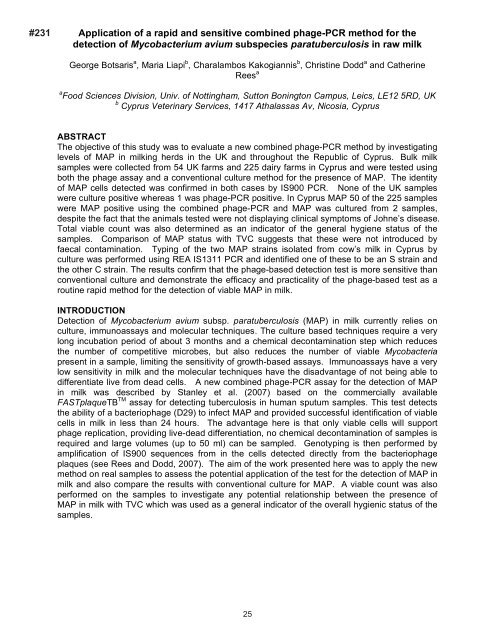Proceedings of the 10th International Colloquium on Paratuberculosis
Proceedings of the 10th International Colloquium on Paratuberculosis
Proceedings of the 10th International Colloquium on Paratuberculosis
Create successful ePaper yourself
Turn your PDF publications into a flip-book with our unique Google optimized e-Paper software.
#231<br />
Applicati<strong>on</strong> <str<strong>on</strong>g>of</str<strong>on</strong>g> a rapid and sensitive combined phage-PCR method for <str<strong>on</strong>g>the</str<strong>on</strong>g><br />
detecti<strong>on</strong> <str<strong>on</strong>g>of</str<strong>on</strong>g> Mycobacterium avium subspecies paratuberculosis in raw milk<br />
George Botsaris a , Maria Liapi b , Charalambos Kakogiannis b , Christine Dodd a and Ca<str<strong>on</strong>g>the</str<strong>on</strong>g>rine<br />
Rees a<br />
a Food Sciences Divisi<strong>on</strong>, Univ. <str<strong>on</strong>g>of</str<strong>on</strong>g> Nottingham, Sutt<strong>on</strong> B<strong>on</strong>ingt<strong>on</strong> Campus, Leics, LE12 5RD, UK<br />
b Cyprus Veterinary Services, 1417 Athalassas Av, Nicosia, Cyprus<br />
ABSTRACT<br />
The objective <str<strong>on</strong>g>of</str<strong>on</strong>g> this study was to evaluate a new combined phage-PCR method by investigating<br />
levels <str<strong>on</strong>g>of</str<strong>on</strong>g> MAP in milking herds in <str<strong>on</strong>g>the</str<strong>on</strong>g> UK and throughout <str<strong>on</strong>g>the</str<strong>on</strong>g> Republic <str<strong>on</strong>g>of</str<strong>on</strong>g> Cyprus. Bulk milk<br />
samples were collected from 54 UK farms and 225 dairy farms in Cyprus and were tested using<br />
both <str<strong>on</strong>g>the</str<strong>on</strong>g> phage assay and a c<strong>on</strong>venti<strong>on</strong>al culture method for <str<strong>on</strong>g>the</str<strong>on</strong>g> presence <str<strong>on</strong>g>of</str<strong>on</strong>g> MAP. The identity<br />
<str<strong>on</strong>g>of</str<strong>on</strong>g> MAP cells detected was c<strong>on</strong>firmed in both cases by IS900 PCR. N<strong>on</strong>e <str<strong>on</strong>g>of</str<strong>on</strong>g> <str<strong>on</strong>g>the</str<strong>on</strong>g> UK samples<br />
were culture positive whereas 1 was phage-PCR positive. In Cyprus MAP 50 <str<strong>on</strong>g>of</str<strong>on</strong>g> <str<strong>on</strong>g>the</str<strong>on</strong>g> 225 samples<br />
were MAP positive using <str<strong>on</strong>g>the</str<strong>on</strong>g> combined phage-PCR and MAP was cultured from 2 samples,<br />
despite <str<strong>on</strong>g>the</str<strong>on</strong>g> fact that <str<strong>on</strong>g>the</str<strong>on</strong>g> animals tested were not displaying clinical symptoms <str<strong>on</strong>g>of</str<strong>on</strong>g> Johne’s disease.<br />
Total viable count was also determined as an indicator <str<strong>on</strong>g>of</str<strong>on</strong>g> <str<strong>on</strong>g>the</str<strong>on</strong>g> general hygiene status <str<strong>on</strong>g>of</str<strong>on</strong>g> <str<strong>on</strong>g>the</str<strong>on</strong>g><br />
samples. Comparis<strong>on</strong> <str<strong>on</strong>g>of</str<strong>on</strong>g> MAP status with TVC suggests that <str<strong>on</strong>g>the</str<strong>on</strong>g>se were not introduced by<br />
faecal c<strong>on</strong>taminati<strong>on</strong>. Typing <str<strong>on</strong>g>of</str<strong>on</strong>g> <str<strong>on</strong>g>the</str<strong>on</strong>g> two MAP strains isolated from cow’s milk in Cyprus by<br />
culture was performed using REA IS1311 PCR and identified <strong>on</strong>e <str<strong>on</strong>g>of</str<strong>on</strong>g> <str<strong>on</strong>g>the</str<strong>on</strong>g>se to be an S strain and<br />
<str<strong>on</strong>g>the</str<strong>on</strong>g> o<str<strong>on</strong>g>the</str<strong>on</strong>g>r C strain. The results c<strong>on</strong>firm that <str<strong>on</strong>g>the</str<strong>on</strong>g> phage-based detecti<strong>on</strong> test is more sensitive than<br />
c<strong>on</strong>venti<strong>on</strong>al culture and dem<strong>on</strong>strate <str<strong>on</strong>g>the</str<strong>on</strong>g> efficacy and practicality <str<strong>on</strong>g>of</str<strong>on</strong>g> <str<strong>on</strong>g>the</str<strong>on</strong>g> phage-based test as a<br />
routine rapid method for <str<strong>on</strong>g>the</str<strong>on</strong>g> detecti<strong>on</strong> <str<strong>on</strong>g>of</str<strong>on</strong>g> viable MAP in milk.<br />
INTRODUCTION<br />
Detecti<strong>on</strong> <str<strong>on</strong>g>of</str<strong>on</strong>g> Mycobacterium avium subsp. paratuberculosis (MAP) in milk currently relies <strong>on</strong><br />
culture, immunoassays and molecular techniques. The culture based techniques require a very<br />
l<strong>on</strong>g incubati<strong>on</strong> period <str<strong>on</strong>g>of</str<strong>on</strong>g> about 3 m<strong>on</strong>ths and a chemical dec<strong>on</strong>taminati<strong>on</strong> step which reduces<br />
<str<strong>on</strong>g>the</str<strong>on</strong>g> number <str<strong>on</strong>g>of</str<strong>on</strong>g> competitive microbes, but also reduces <str<strong>on</strong>g>the</str<strong>on</strong>g> number <str<strong>on</strong>g>of</str<strong>on</strong>g> viable Mycobacteria<br />
present in a sample, limiting <str<strong>on</strong>g>the</str<strong>on</strong>g> sensitivity <str<strong>on</strong>g>of</str<strong>on</strong>g> growth-based assays. Immunoassays have a very<br />
low sensitivity in milk and <str<strong>on</strong>g>the</str<strong>on</strong>g> molecular techniques have <str<strong>on</strong>g>the</str<strong>on</strong>g> disadvantage <str<strong>on</strong>g>of</str<strong>on</strong>g> not being able to<br />
differentiate live from dead cells. A new combined phage-PCR assay for <str<strong>on</strong>g>the</str<strong>on</strong>g> detecti<strong>on</strong> <str<strong>on</strong>g>of</str<strong>on</strong>g> MAP<br />
in milk was described by Stanley et al. (2007) based <strong>on</strong> <str<strong>on</strong>g>the</str<strong>on</strong>g> commercially available<br />
FASTplaqueTB TM assay for detecting tuberculosis in human sputum samples. This test detects<br />
<str<strong>on</strong>g>the</str<strong>on</strong>g> ability <str<strong>on</strong>g>of</str<strong>on</strong>g> a bacteriophage (D29) to infect MAP and provided successful identificati<strong>on</strong> <str<strong>on</strong>g>of</str<strong>on</strong>g> viable<br />
cells in milk in less than 24 hours. The advantage here is that <strong>on</strong>ly viable cells will support<br />
phage replicati<strong>on</strong>, providing live-dead differentiati<strong>on</strong>, no chemical dec<strong>on</strong>taminati<strong>on</strong> <str<strong>on</strong>g>of</str<strong>on</strong>g> samples is<br />
required and large volumes (up to 50 ml) can be sampled. Genotyping is <str<strong>on</strong>g>the</str<strong>on</strong>g>n performed by<br />
amplificati<strong>on</strong> <str<strong>on</strong>g>of</str<strong>on</strong>g> IS900 sequences from in <str<strong>on</strong>g>the</str<strong>on</strong>g> cells detected directly from <str<strong>on</strong>g>the</str<strong>on</strong>g> bacteriophage<br />
plaques (see Rees and Dodd, 2007). The aim <str<strong>on</strong>g>of</str<strong>on</strong>g> <str<strong>on</strong>g>the</str<strong>on</strong>g> work presented here was to apply <str<strong>on</strong>g>the</str<strong>on</strong>g> new<br />
method <strong>on</strong> real samples to assess <str<strong>on</strong>g>the</str<strong>on</strong>g> potential applicati<strong>on</strong> <str<strong>on</strong>g>of</str<strong>on</strong>g> <str<strong>on</strong>g>the</str<strong>on</strong>g> test for <str<strong>on</strong>g>the</str<strong>on</strong>g> detecti<strong>on</strong> <str<strong>on</strong>g>of</str<strong>on</strong>g> MAP in<br />
milk and also compare <str<strong>on</strong>g>the</str<strong>on</strong>g> results with c<strong>on</strong>venti<strong>on</strong>al culture for MAP. A viable count was also<br />
performed <strong>on</strong> <str<strong>on</strong>g>the</str<strong>on</strong>g> samples to investigate any potential relati<strong>on</strong>ship between <str<strong>on</strong>g>the</str<strong>on</strong>g> presence <str<strong>on</strong>g>of</str<strong>on</strong>g><br />
MAP in milk with TVC which was used as a general indicator <str<strong>on</strong>g>of</str<strong>on</strong>g> <str<strong>on</strong>g>the</str<strong>on</strong>g> overall hygienic status <str<strong>on</strong>g>of</str<strong>on</strong>g> <str<strong>on</strong>g>the</str<strong>on</strong>g><br />
samples.<br />
25






